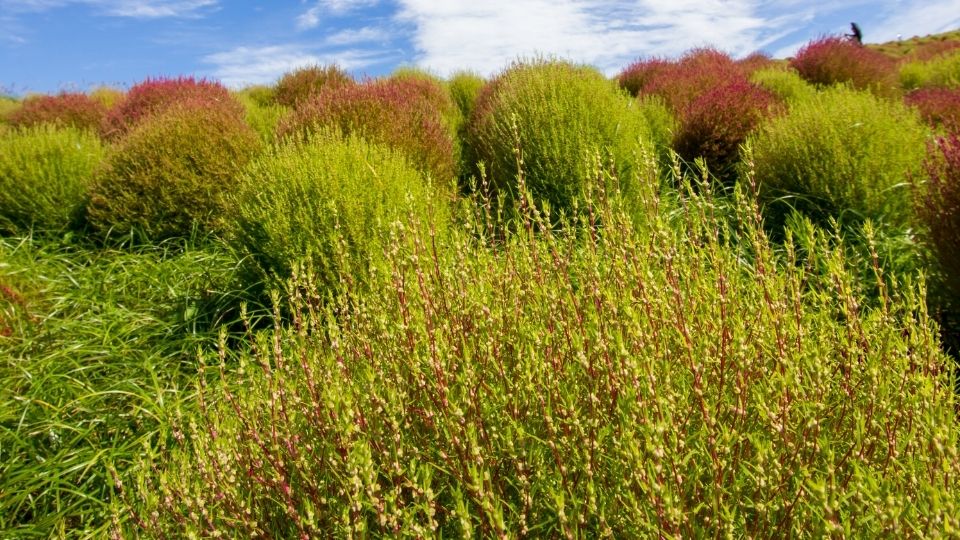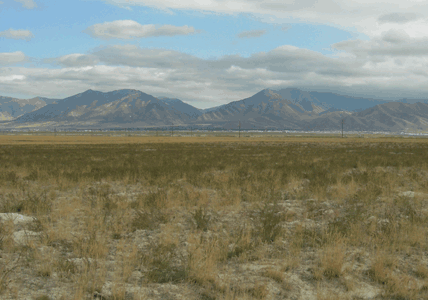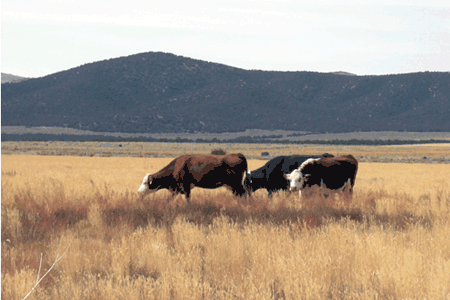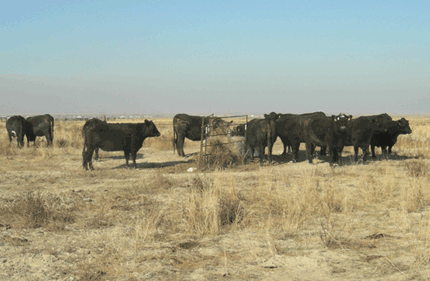Forage Kochia

Project Participants: Linden Greenhalgh, Dale ZoBell, Blair Waldron, Ken Olson, Burke Davenport, Bruce Clegg and Darrell Johnson
Forage kochia is drought and salt tolerant as well as fire resistant. Carrying capacity can be increased six-fold by planting forage kochia on grass-dominated ranglands. It is an excellent forage in fall and winter due to its high protein content and good digestibility. The study presented here was conducted in Tooele County, Utah. Forage quality, production, availability, and carrying capacity were greater in pastures with forage kochia compared with crested wheatgrass pastures.

to grazing (photo by Linden Greenhalgh
- Publications
- Project Participants
- USDA Plant Guide - Forage Kochia
- Another Forage Kochia Project in Utah - Box Elder County
This project was funded by Western SARE (Sustainable Agriculture Research and Education). Below is an edited version of the final report on the project. Full report.
Perennial Forage Kochia for Improved Sustainability of Grass-Dominated Ecosystems
Summary
Forage kochia produces well in arid conditions and meets animal requirements for protein. For these reasons, winter-feed costs can be reduced by including it as a component of rangelands. When combined with crested wheatgrass, which meets requirements for energy, it can significantly increase carrying capacity. Forage production average or lower than average for control pastures, but pastures with kochia exceeded average expected production.
Cattle on rangelands with forage kochia had a greater increase in body condition score (BCS) than cattle on crested wheatgrass rangelands. This is probably a result of the much higher crude protein (CP) contained in forage kochia as compared to the grass. Forage kochia also had equivalent digestibility, but more favorable fiber values (ADF and NDF), compared to grass. Most noteworthy from this study was a nearly six-fold increase in forage production in the forage kochia pastures. Overall, results indicate that planting forage kochia to improve winter rangelands increases sustainability of livestock production in the Western United States.

in Fall (photo by Linden Greenhalgh
Background
Forage or prostrate kochia is native to the heavily grazed rangeland regions of Central Eurasia. It is a long-lived, perennial, semi-evergreen half-shrub that is well adapted to Western U.S. rangelands, including those high in salt and alkali. Forage kochia is different from the weedy annual kochia because it is a perennial, it is non-invasive to native perennial plant communities, and it does not cause nitrate or oxalate toxicity Harrison concluded that forage kochia does not invade perennial plant communities, but can stabilize disturbed sites by competing against annual species. Forage kochia out-competes many noxious annual weeds including cheatgrass (Fig. 1) and halogeton. Once it has replaced cheatgrass, perennial native species can re-establish in the stand of forage kochia, thus leading to diverse, stable perennial plant communities.
Forage kochia has proved to be effective in greenstrips to stop wildfires (Fig. 2) on western rangelands. Its active summer growth and ability to create zones with reduced cheatgrass contributes to its ability to slow or stop wildfires.
Forage kochia is an important fall and winter forage for sheep, cattle, horses, camels, and wildlife in Kazakhstan and Uzbekistan. Preliminary research and anecdotal evidence in the U.S. has shown that grazing forage kochia on Western rangelands may reduce winter-feeding costs and increase the sustainability of livestock production because it grows in arid conditions and has crude protein levels that exceed ruminant nutrient requirements during the critical fall and winter months.
A major challenge for beef producers in the Western United States is high winter feed costs. Grazing low-quality forage while minimizing use of expensive supplements is one way to reduce feed costs. Arthun reported including forbs and shrubs in low-quality forage-based diets improves forage quality. Improving winter grazing is important economically because it can reduce costs associated with feeding stored hay. Shrubs are particularly important in winter grazing systems. During winter, dormant grasses are high in energy (fiber) but low in protein. Simultaneously, shrubs such as forage kochia are low in energy and high in protein. Combining grasses and shrubs can optimize protein and energy levels by meeting microbial crude protein requirements of 7% during winter.
Objectives
Our research objective was to evaluate livestock nutrient intake and performance responses to rangeland with or without forage kochia. Our extension objective was to integrate this knowledge with previous knowledge about forage kochia to impact clientele knowledge, awareness, attitudes and skills.
Materials and Methods
Site Information: The study took place in two successive years (2007 & 2008) at two locations: one in the Tooele Valley on land owned by the Grantsville Conservation District, the other in Rush Valley on land owned by Darrell Johnson, a local rancher. The two sites are approximately 18 miles apart and have different ecological site descriptions.

cattle in Fall (photo by Linden Greenhalgh).
Ecological Site Descriptions:
Tooele Valley
- Site Name: Semi-Desert Alkali Loam (Black Greasewood)
- Location: (lat 40º 34’ 16.91” N, long 112° 24’ 25.74” W)
- Elevation: 4800 to 5300 feet above sea level
- Annual precipitation: 8-12 inches
- Mean annual air temperature: 45 to 52
- Frost free period: 100 to 150 days
- Expected average forage production: 500 to 650 lbs/acre
Rush Valley
- Site Name: Upland Loam (Mountain Big Sagebrush)
- Location: (lat 40° 19’ 17.90” N, long 112º 29’ 36.44” W)
- Elevation: 4300 to 7000 feet above sea level
- Annual precipitation: 12 to 16 inches
- Mean annual air temperature: 47 to 50 degrees F
- Frost-free period: 100 to 120 days
- Expected average forage production: 1150 to 1200 lbs/acre.
Kochia Establishment: One-hundred eight acres in Tooele Valley and one-hundred twenty-eight acres in Rush Valley were prepared by disking and seeded with forage kochia at a rate of 2 lbs/acre of pure live seed.
Forage Evaluation: Forage production in 2008 was the average of 32 subsamples at each location within each treatment. Forage production in 2007 is from NRCS double sampling method. Species of plants not used by cattle were excluded.
Results and Discussion
While the difference between final BCS for both groups was not significantly different the difference between the BCS changes in groups was. Both control and kochia pastures had adequate forage to increase BCS.
The difference in forage production between treatments was the most notable difference in this study. Forage kochia thrived during hot dry conditions. Data show an almost six-fold increase in production, which translates to increased carrying capacity.

grazing (photo by Linden Greenhalgh).
Forage kochia had similar overall digestibility compared to grass but crude protein value was greater and fiber digestibility more favorable. Total fry matter was 441 and 2586 kg/ha for the control versus kochia pastures respectively (P=.0007). Forage quality for control and forage kochia was 3.1 and 11.7% for crude protein; 41.2 and 34.2% for acid detergent fiber; 64.7 and 45.7% for neutral detergent fiber; and 62.9 and 63.5% for digestibility.
Increasing producer knowledge, awareness, attitudes, and skills: There is a great deal of curiosity about forage kochia based on interest at field days and inquiries by producers from throughout the Intermountain West. Producers are requesting applied and timely information so they can adopt the use of forage kochia to improve fall and winter grazing
The second benefit of this study comes from on farm/ranch research. The typical model of adoption of new practices by agricultural producers suggests that once this first group of producers demonstrates the value of the practice among their community of peers, then positive attitudes and adoption of practices spreads throughout the region. This suggests that the demonstration of research results in producer enterprises is a highly successful means of increasing producer knowledge, awareness, attitudes and skills. Not only did we affect the producers directly involved in this project, but also their neighbors and others outside the geographic area of the project.
Extension efforts transferred existing and new knowledge about forage kochia to diverse clientele including producers, public land managers, wildlife managers, conservation agencies, environmental groups, and rural community governments. Information was transferred through traditional technology transfer methods such as fact sheets, study site visits with producers and discussions and presentations at Extension and research meetings. Results were published in reports that were made available in traditional print as well as published on the USU Extension web page
Producer involvement: Producer cooperators, Darrell Johnson and the members of the grazing association that graze the Grantsville Soil Conservation District (SCD) land, did not have direct experience with forage kochia, but were aware of the potential advantages and wanted to gain knowledge and experience with it. The investigators and these cooperators interacted in planning the research and extension efforts. They agreed to be involved, including providing land and cattle, execution of the research, and dissemination of results. The producers using the Grantsville SCD land were very supportive and felt the project had great value because it was designed on a landscape scale, with each pasture containing over 150 acres and supporting 20 or more cows.
Additionally, the City of Grantsville was interested because the soil conservation district land involved surrounds the city on three sides and has been the site of past wildfires that threatened the city. Thus, they were supportive of incorporating forage kochia greenstrips in the research trials that were placed to protect the city from fires.
Economic Analysis: Economic impacts for livestock producers include improved profitability in livestock enterprises. An improved supply of nutrients from perennial forages has led to improved animal performance and carrying capacity, which, in turn, reduce supplemental feed costs improving economic viability. Improved wildlife habitat may lead to more opportunities for producers by providing the opportunity to diversify into wildlife enterprises, such as game hunting. Increased quality of life for producers should include improved profit and reduced time and labor commitments to livestock enterprises.
Impacts for land managers include reduced costs for fire control and fire rehabilitation. This in turn is an economic impact for all taxpayers because of tax support for the land management agencies.
Tillage and seeding of pastures was approximately $50.00/acre. Seed cost of forage kochia varied during the course of this study and was as high as $20.00/lb. Kochia takes time to establish but once a healthy stand is ready for grazing it greatly increases carrying capacity. The forage kochia grazing system would have been more profitable due to lower costs due to the six-fold increase in carrying capacity. This is based on approximately $45-$50 / AUM to feed stored feeds and approximately $16-$20 / AUM to pay for pasture rent and fees. Grazing systems are also much less labor intensive.
Farmer Adoption: Many farmer/ranchers in Tooele County have previously planted forage kochia. It has in some cases been difficult to get established. However, producers aren’t always sure what they need to look out for when in fact the plant has germinated and is established but in a dormant state until sufficient moisture allows the plant to grow.
Publications
- Waldron, B.L.,J..S. Eun, D.R. ZoBell, K.C. Olson. 2010 Forage kochia (Kochia prostrata) for fall and winter grazing. Small Ruminant Research 91:47-55.
- Greenhalgh, L.K., D.R. ZoBell, B.L. Waldron, K.C. Olson, and B.W. Davenport. 2010. Increased Carrying Capacity with Perennial Forage Kochia. Journal of Extension 48(6):6RIB7.
- Greenhalgh, L.K., K.C. Olson, D.R. ZoBell, B.L. Waldron, A.R. Moulton, and B.W. Davenport. 2008. Perennial forage kochia for improved productivity of grass dominated winter grazing pastures. WSASAS Proceedings, Vol. 59:210-212.
- Wood, M., B. Waldron, N.J. Chatterton and D.R. ZoBell. 2006. Nutritious treat for cattle and wildlife: forage Kochia. USDA Agricultural Research, January, 2006 p.18-19.
- Waldron, B.L., D.R. ZoBell, K.C. Olson, K.B. Jensen, D.L. Snyder. 2006. Stockpiled forage kochia to maintain beef cows during winter. Rangeland Ecology and Management. Vol. 59:275-284
- ZoBell, D.R., B.L. Waldron, K.C. Olson, R.D. Harrison, and H. Jensen. 2004. Utilization of forage kochia for fall/winter grazing. Proceedings, WSASAS, Vol. 55:282-284.
Project Participants
For more information on forage kochai, contact Linden Greenhalgh, Blair Waldron, or Burke Davenport below.
Linden K. Greenhalgh
Extension Assistant Professor
Utah State University Cooperative Extension
Tooele, Utah
linden.greenhalgh@usu.edu
Dale R. ZoBell
Professor
Utah State University Cooperative Extension
Logan, Utah
Blair L. Waldron
Research Geneticist
USDA-ARS Forage and Range Research Lab
Logan, Utah
blair.waldron@ars.usda.gov
Kenneth C. Olson
Professor
South Dakota State University
Rapid City, South Dakota
Burke W. Davenport
Range Conservationist
USDA-Natural Resources Conservation Service
Filmore, Utah
burke.davenport@ut.nrcs.gov
Bruce Clegg
Grantsville Soil Conservation District
358 E Church Road
Tooele , UT
Darrell Johnson
166 S Johnson Lane
Rush Valley , UT

